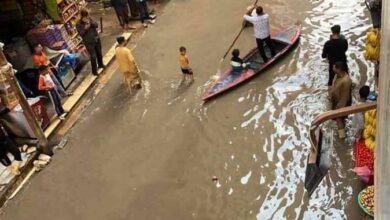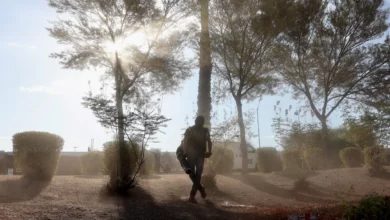
The Nile Delta region produces no less than 65 percent of the Egypt’s total agricultural production. It is also part of the country’s most densely populated regions; half of Egypt’s ever expending population lives in this triangle of fertile land, a zone identified as one of the world’s most vulnerable to climate change. Since the Delta’s coastal cities are built at a very low elevation, a mere 0.5 centimeter rise in sea level could plunge cities like Alexandria, Damietta, Rashid and Port Said underwater, displacing millions of inhabitants from their homes and destroying the region’s thriving agriculture. But as the sea nibbles bits of coast, the sea water makes its way underground and invades delta aquifers, posing an immediate threat to crops and yields.
The Nile Delta aquifer is one of the largest groundwater reservoirs in the world. Spread over 6 million acres, it is immensely precious for Egypt. Because sea water is denser than freshwater (one cubic meter of sea water contains 35kg of salt), sea water easily migrates into the aquifer, mixing with the freshwater and corrupting it.
Mosaad Kotb is the head of the Central Laboratory for Agricultural Climate (CLAC), a central laboratory of the Agricultural Research Center. His research unit, which focuses on the implications of climate change on the agricultural sector, installed bathometers — PVC tubes that measure sea level — 6 months ago along the coasts to identify the rate of sea level increases and incursions into groundwater. “We are starting to collect the data now, but we are aware that the results won’t give us the solution on how to mitigate the seeping of saline water into the aquifer in the long term,” Kotb admits.
He explains that the construction of Aswan dam in 1973 deprived the delta of its perennial layer of silt that replenished every year with floods and restored nutrients to the soil. “The soil compacts with time, so this phenomenon combined with the sea level rise is extremely alarming,” he says. Some farmers have taken matters into their own hands by adding an extra 50-centimeter-high sand bed atop their fields to combat rising sea levels, but the results are inconclusive.
“The sand is poor in nutrients, and needs to be sprayed consistently with fertilizers to grow anything,” Kotb explains.
Some experts have recommended cultivating rice north of Cairo to rebuff the influx of saline water. Mohamed al-Raey, chairman of the Environment Committee at the Supreme Council of Egyptian Universities, explains that rice cultivation could decrease the water's salinity because it involves the heavy use of fresh water.
Raey explains that there is no institutional body capable of monitoring and assessing salt water intrusion in groundwater, except for the CLAC, which has experimented with bathometers. “This is a first step to identifying the extent of saline water intrusion, but in parallel we should be carrying out research on salt tolerant crops, on new ways of preserving fresh water and we should establish drip irrigation systems all over Delta agricultural lands,” he stresses.
Another major need, according to the environmentalist, is to create new and sheltered areas of cultivation that could absorb significant pockets of population and relieve pressure off the Delta.
“Sinai and the North coast should be developed agriculturally, this is the only way to foresee a sustainable future for Egypt’s agriculture,” he says.
He is worried by the nonchalance of the various ministries involved — tourism, agriculture, environment, land reclamation, water resources and irrigation — but admits that he is not surprised. He explains that most decision-makers are not interested in tackling an environmental phenomenon expected to rear its ugly head in 10 years.
Without proper policies, however, problems posed by sea level rises and the saline water seepages cannot be mitigated.
Kotb is fully aware that politicians have other priorities aside from solving environment-related problems, even when they threaten the country’s economy. But in case the researchers receive appropriate funding, these are the four points they would start studying immediately: “First, we should build better walls in the most vulnerable areas to effectively prevent coastal erosion, then we should increase the drainage of the agricultural wastewater and pump it out of the area,” Kotb explains. “Thirdly, we should reach a better water use efficiency by giving farmers incentives to abandon the mixed crops pattern which they currently use, to focus on growing one crop and by installing service irrigation.”
Another activity which could be hit by increasing sea levels and higher salinity is fishing. Sixty percent of Egypt’s fisheries are located in the Delta lakes, and although no study has been conducted to study the potential impact of higher salinity on fisheries, Abdel Rahman al-Gamal, a senior aquaculture scientist at the World Fish Center for Africa, is concerned.
“Some fish species can adapt and tolerate certain levels of salinity, like the mullet which is a migratory fish,” he says. According to the expert, this fish can survive with minor quantities of salt in the water. But for other more sensitive species like the cat-fish, increased salinity can lead to its extermination.
“We are talking about the modification of the entire wetland ecosystem, he says, not only fish but also aquatic plants will be impacted, and possibly destroyed,” says Gamal. These plants, which currently act as a filter of all the industries’ wastewater and protect the marine life, may perish in the process. According to Gamal, the variety of fish species could decrease, and new species of fish could invade the lakes from the sea.
For the past 15 years, Raey has been pushing for the creation of a trans-ministries body which would focus solely on the effects of climate change, “but the government still isn’t showing any willingness to set it up,” he laments.




